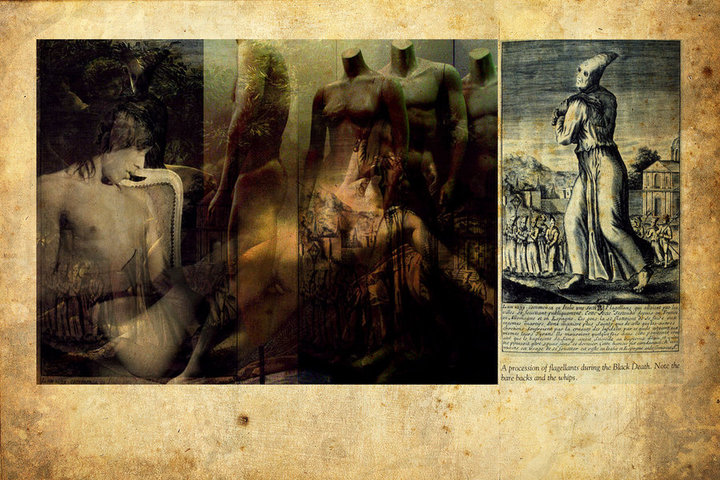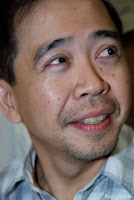Going across a gallery full of Gromyko Semper ink/watercolor paintings and drawings (with his few oils) can be likened to listening to early Uriah Heep or some such old progressive rock music with all that typical fantastic abandon and iconoclastic humor. But, for now, we can’t be sure if Semper is merely an intelligent humorist, a happy/hermetic fantasist or a serious iconoclast.

The Minotaur's Recompense
Semper As Per Iconoclasm
Semper As Per Iconoclasm
We’re not talking about the iconoclasm of destruction, of course, but the one more suited to our time and the artist’s profession—and that’s the type that appropriates, twists, and finally destroys the icon by emulating the snake that eats another snake to make that eaten snake this living renewed snake outside.
Semper’s pieces aren’t lovely as someone’s hare’s portrait, that’s obvious, but are snake-like in their charm. They actually appropriate religious and other humanist mythologies via their iconographic imagery and instantly parody (or generously twist) these. And the way Semper parodies ‘em all! He actually enters the art of iconography, goes through the religiosity of ceremonious patience in creating details, as if he were one of those craftsmen called by the mughal to decorate the Taj tiles or by the Jesuits to Mexicanize Santa Maria Tonantzintla Church
And this is precisely where a Semper can go beyond being merely charming and become quite a delight. Because you religiously go through the details with the artist, examine with him each Breughelian serpentization of a scepter, each demonization of an immaculate virgin to expose her false demigoddess-ness in a gallery collective of false demigod-ness. And here is our signal to ask: Is Semper’s imagery a product of some heavy metal pseudo-Satanism or of a serious Hieronymus Bosch-ness (were Bosch a Reformationist)?
The answer to this question will vary, of course, from gallery visitor to another, from critic to critic. For each Semper piece is a potential conversation piece, provoking conversations which can snake their way into historical alluding, quoting, complicit denigrating as well as faithful defending. And that can only be so because in all their Albrecht Durer-like complexity, Semper’s detailed ink composites are in effect war sermons of disgust with the human history of religious iconographic lies and semi-lies.
Baroque Sempernoza
But forget for the moment that Semper was the first Filipino to be invited to participate in Keith Wigdor’s (and the International Surrealist Movement in the 21st Century’s) international Surrealism Now exhibit in Coimbra, Portugal. Or that before he went there in May of this year he co-edited with Héctor Pineda the book Imagine the Imagination: New Visions of Surrealism, published in Poland
Now the question might be asked: why would anyone in this religious country given to baroque Marian art be attracted to invest in a Semper of a seemingly new Filipino Enlightenment? Why would local galleries even be enthused to have him? Well, perhaps that’s the point. If Jose Saramago wasn’t Portuguese, his literary iconoclasm wouldn’t mean anything, would it? Yet, in the Catholic city of Lisboa, Saramago’s “anti-Christian” books had been commercial successes, the earlier one helped perhaps by his exile, the latter helped by the media focus on the Nobel Laureate’s newfound notoriety.
A Catholic country is the perfect, nay the logical, market/audience for new anti-religious or anti-humanist iconoclasm. Sempers can actually decorate a restaurant’s corners, emitting both decorative values as well as intelligent informed symbologies among dining historians, semioticians, and some such group of Filipino intellectuals.
So,…I mentioned heavy metal sensibilities (sans the airbrush) as well as intellectual freethinking ones. But beyond those circles and the esthetic formalist, is there another audience for Semper’s Voltairean titles? Oh yes, of course—there’s the J.R.R. Tolkien fan, the literary fan of archaic myths, as well as the ardent admirer of craftsmen’s patience. And, lastly, the investor in difficult craft who may care little for the fact that not all complex craftsmanship is intelligent art.
Semper Fidelis
That’s our signal. Now let’s examine Semper’s intelligence beyond the craft.
In his fidelity to details as well as to the exactitude of his titles, all in the hope perhaps of arriving at Umberto Eco’s “closed text” level for a more universal reading, Semper’s pieces are not simple book-illustration material however. While Our Lady of Perpetual Abandon is classic transparent parody, for instance, Eulogy to Melancholy (Whose Tormentors Appear Before Pleroma) is a semiotic field that could allude to as many significances as one can muster—one of which could allude to Napoleonic self-crownings sanctioned by divine authority. Paracelsus Preparing the Sacrae Particulae Ex Nihilo, meanwhile, could be an homage to the Renaissance alchemist’s magic, as if Paracelsus is one of surrealist/visionary art’s inspirers. And while Hecate, Anubis, Consus may be deemed a subtle bow to Hieronymus Bosch panel paintings qua literary narrative-cum-satire, only this time using Roman gods instead of Christian ones, The Hermetic Fool might be read as both a sneer and a tribute portrait. And while The Vessel of Balaam goes beyond parody to wax loud mockery, Circe’s Ventriloquy skips loud parody to subtly portray a heroine/villain as a good/evil motherly lady with leprous hands.
So, there you are. It’s not as though the sacrae particulae of Semper-headedness came ex nihilo. And that intentionality is precisely what separates this new surrealism from good ol’ automatist surrealism. [V]
| Our Lady of Perpetual Abandon |
 |
| A Eulogy to Melancholy (Whose Tormentors Appear Before the Presence of Pleroma) |
 |
Hecate, Anubis, Consus (Novus Ordo Mundi: Bestiality)
|
All seven drawing-paintings are 12 x 18 in., in watercolor on paper board
------------------------------------------
My personal take on Gromyko Semper’s The Minotaur’s Recompense:
It is easy to dismiss Gromyko Semper's The Minotaur's Recompense as just another craftsman's artisanal ink rendering of an archaic literary or political myth. A second look, however, would remind one of Picasso's variations on the Minotaur as symbol of the pampered figure of a civilization (in his earlier etchings) as well as the expressionless witness of civilizations' carnages (as in his Guernica
For his own Minotaur painting, Semper uses a title that would allude more to Giorgio de Chirico's The Soothsayer's Recompense, which was essentially a painting about Ariadne left by Theseus in the Minotaur's Labyrinth.
Consider the possibility that de Chirico's painting is as political asGuernica island of Naxos Germany
In Semper's version, however, it's the Minotaur who is compensated. But here the puzzle begins. Visually the ink painting is already quite a puzzle, literally puzzling as well as referentially. Referentially, is the figure above the lying Minotaur the figure of Theseus, or is it the Minotaur's own double? Are Theseus and the Minotaur one? Did Theseus, in this painting, end up as the Minotaur's lover? Is the figure above holding a weapon or a lollipop? If that's not Theseus, is it Dionysus? Is it Ariadne, who in this gay-baiting suspicious question may be deemed as "really a man"?
Consider the possibility that de Chirico's painting is as political as
In Semper's version, however, it's the Minotaur who is compensated. But here the puzzle begins. Visually the ink painting is already quite a puzzle, literally puzzling as well as referentially. Referentially, is the figure above the lying Minotaur the figure of Theseus, or is it the Minotaur's own double? Are Theseus and the Minotaur one? Did Theseus, in this painting, end up as the Minotaur's lover? Is the figure above holding a weapon or a lollipop? If that's not Theseus, is it Dionysus? Is it Ariadne, who in this gay-baiting suspicious question may be deemed as "really a man"?
Contextually, a symbolic question would be: if in Semper's mythology it's the Minotaur who won, and his recompense becomes Theseus or Dionysus or Ariadne, what political allusion—if any—is Semper pushing? If the Minotaur is as much a symbol of an evil ruler luxuriant in his Labyrinth as of religiosity (as in Guernica
This is no simple illustration. For it would seem that Semper is open to a further twisting of this, his own twisting upon Picasso’s and de Chirico’s twisting of a perpetually twistable theme. [END]
This is no simple illustration. For it would seem that Semper is open to a further twisting of this, his own twisting upon Picasso’s and de Chirico’s twisting of a perpetually twistable theme. [END]


























